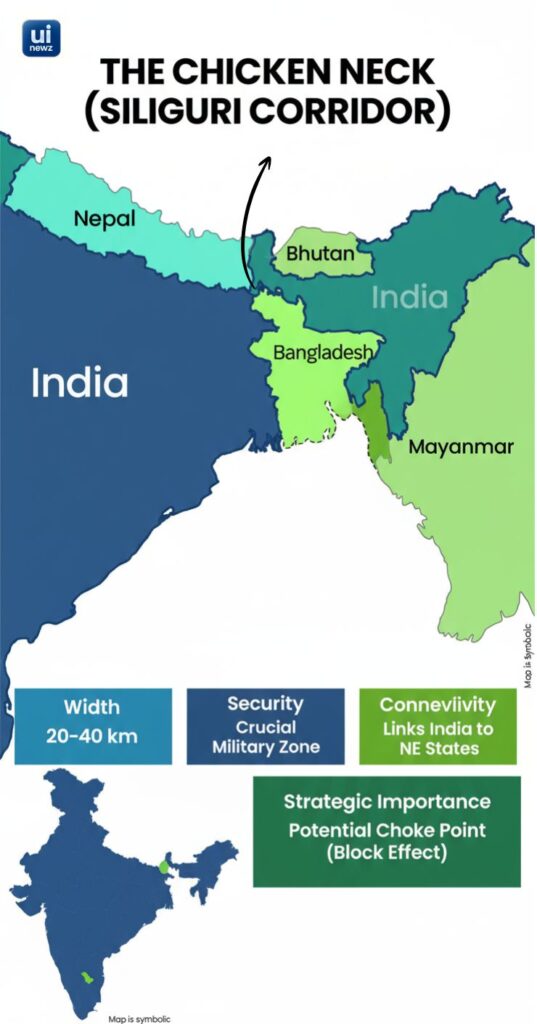
India has initiated major strategic moves to reinforce its control over the Siliguri Corridor, also known as the ‘Chicken’s Neck,’ amid growing concerns over Bangladesh’s interim government warming up to Pakistan. The decision to establish new garrisons along the border underscores India’s intent to secure its Northeast connectivity and prevent potential geopolitical vulnerabilities.
The development comes at a time when Bangladesh, under Nobel laureate Muhammad Yunus, has shown signs of foreign policy realignment, with reports of Pakistani military officials visiting Dhaka and discussions on defense cooperation raising red flags in New Delhi.
What is the Chicken’s Neck?
The Siliguri Corridor is a narrow stretch of land in West Bengal, barely 20-22 kilometers wide at its narrowest point, that connects mainland India to its seven northeastern states. Flanked by Nepal to the west, Bangladesh to the south, and Bhutan to the north, this slender passage earned its nickname for its resemblance to a chicken’s neck on a map.
This corridor is the only land route linking the Northeast (Assam, Arunachal Pradesh, Nagaland, Manipur, Mizoram, Tripura, and Meghalaya) to the rest of India. All road and rail traffic for 45 million people in the region must pass through this geographic bottleneck.
Why is it strategically important?
The corridor represents India’s most critical vulnerability. Any disruption here, whether from military conflict, natural disasters, or political instability, would effectively isolate the entire northeastern region from mainland India, creating massive challenges for administration, trade, and national security.
The geopolitical sensitivity is heightened by the corridor’s proximity to international borders and the tri-junction of India, Bhutan, and China. The 2017 Doklam standoff demonstrated how vulnerable this region is to external threats. Unlike other border areas where India has strategic depth, the Chicken’s Neck is an all-or-nothing proposition for territorial integrity.
For India, losing control or access to this corridor would mean severing physical connectivity with one-eighth of its territory and population, making it a non-negotiable strategic asset.

What are the recent developments?
Recently, India has undertaken significant military reinforcements in response to shifting regional dynamics. Three new fully operational military garrisons have been established at Bamuni (near Dhubri), Kishanganj, and Chopra along the Indo-Bangladesh border. These installations significantly enhance surveillance, rapid response capabilities, and logistical support to guard against potential encirclement attempts.
The timing coincides with Bangladesh’s interim government showing closer ties with Pakistan and China. Comments from Bangladeshi leadership describing India’s Northeast as “landlocked” and Bangladesh as the regional “guardian of the ocean” have particularly alarmed Indian strategic planners, as they highlight New Delhi’s dependence on neighborly goodwill for transit routes.
How is India securing the corridor?
The Indian Army’s Trishakti Corps, headquartered near Siliguri, oversees the corridor’s defense with heightened combat readiness. The military presence includes regular live-fire drills, deployment of T-90 tanks, and advanced weaponry systems.
Air defense has been dramatically strengthened with Rafale fighter jets stationed at Hashimara Airbase, along with MiG jets and BrahMos missile regiments. A layered missile defense system comprising Russia’s S-400, the DRDO-Israel jointly developed MRSAM, and the indigenous Akash system provides comprehensive protection against aerial and missile threats.
Defense officials maintain that despite its narrow width, the Siliguri Corridor now ranks among India’s strongest defense points due to concentrated military presence and rapid deployment capabilities.
What about alternative connectivity?
Recognizing the strategic risk of over-dependence on a single corridor, India is actively developing alternative routes. The Kaladan Multi-Modal Transit Project links the Northeast to Kolkata via Myanmar, while the India-Myanmar-Thailand Trilateral Highway opens routes to Southeast Asia.
Infrastructure initiatives under the Bharatmala project and BBIN (Bangladesh, Bhutan, India, Nepal) agreements are creating new railway lines through Nepal and enhanced road networks. These projects aim to diversify supply lines and reduce the Northeast’s vulnerability to geographic or political blockades.
The recent military buildup and infrastructure push reflect India’s comprehensive strategy to secure this vital corridor amid evolving regional challenges, ensuring that the Northeast remains firmly connected to the Indian mainland regardless of shifts in neighboring countries’ foreign policies.






